In Florida, human error causes over 90 percent of the car crashes. Momentary lapses cause a few of these wrecks. A few others happen because the driver was just in the wrong place at the wrong time. But the vast majority involve either negligence, which is a lack of ordinary care, or negligence per se, which is a violation of a safety statutes.
Substantial compensation is usually available to Florida car accident victims. That compensation usually includes money for both economic losses, such as medical bills, and noneconomic losses, such as pain and suffering. However, the insurance company does not simply give this money away. In fact, insurance company lawyers use every trick in the book to reduce the amount of compensation the victim receives, or deny such compensation altogether. Insurance companies do not want what’s fair. They want to avoid payouts and increase their profits.
Comparative Fault
Nearly all car crashes, especially intersection collisions, involve at least some contributory negligence. For example, Driver A may not see Driver B make an illegal lane change because Driver A was distracted.
In Florida, contributory negligence is basically a two-step process. First, the tortfeasor (negligent driver) must convince the judge that the victim’s negligence had some bearing on the wreck. To return to the previous example, Driver A’s “distracted driving” might have been rolling down a window. Such conduct is technically distracted driving, but most people would not consider such behavior negligent.
Next, the jury must apportion fault between the parties. At trial, an attorney can introduce evidence favorable to one side and challenge the other side’s evidence. Therefore, the jury can make a proper determination.
Florida is a pure comparative fault state. Judges divide damages strictly according to fault. So, even if the jury determined that Driver A was 50 percent at fault, Driver A would still obtain a proportional share of damages.
In contrast, neighboring Alabama is a pure contributory negligence state. Even if Driver A was only 1 percent responsible, that person would be ineligible for compensation.
Sudden Emergency
In Florida, contributory negligence usually only reduces the amount of compensation the defendant must give to the victim/plaintiff. Sudden emergency, however, eliminates liability altogether. This rule applies if the tortfeasor:
- Reasonably reacts to
- A sudden emergency.
One scene from Tommy Boy illustrates both elements of this principle. The hood fly-up is definitely a “sudden emergency.” Other more predictable situations, such as a jaywalking pedestrian, may not qualify as such. But perhaps because The Carpenters song distracted him, or perhaps because he is just dense, Tommy drove recklessly after the hood flew up. Therefore, the defense does not apply. Usually, a “reasonable reaction” involves pulling over to the right side of the road.
Last Clear Chance
Rear-end and head-on collisions sometimes involve the last clear chance defense. Basically, the law does not allow victims to simply sit back and let events take their course. Victims must try to avoid crashes whenever possible. So, if a victim fails to avoid a crash, perhaps by changing lanes, the tortfeasor is not liable for damages.
There is also a reasonableness prong in the last clear chance doctrine. Many times, things happen so fast that the victim simply has no time to react. For this rule to apply, the victim must have the last clear chance and not simply any possible chance.
Reach Out to Tenacious Attorneys
Victims should always be ready to answer some common insurance company defenses in court. For a free consultation with an experienced personal injury lawyer in Brandon, contact Reed & Reed. We have four area offices (St. Petersburg, Lakeland, Tampa, and Clearwater).
Resource:
cyberlaw.stanford.edu/blog/2013/12/human-error-cause-vehicle-crashes

